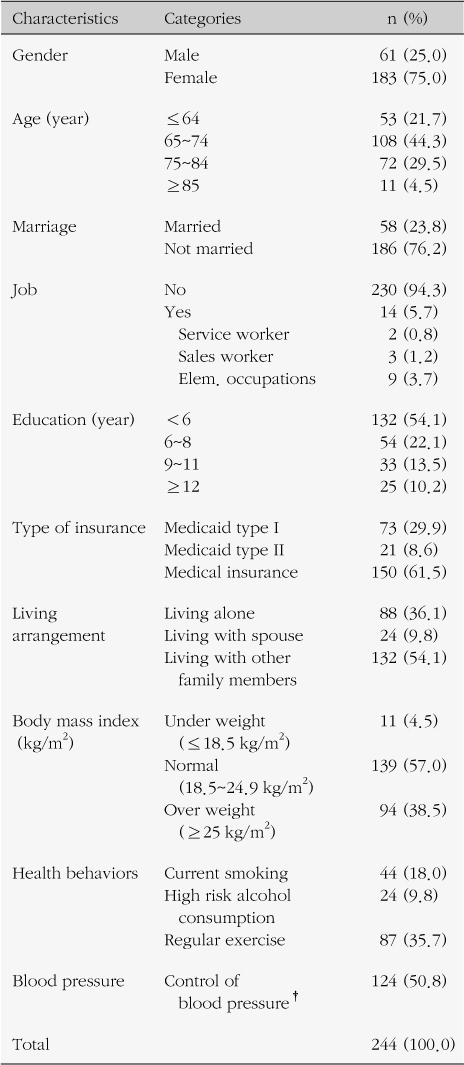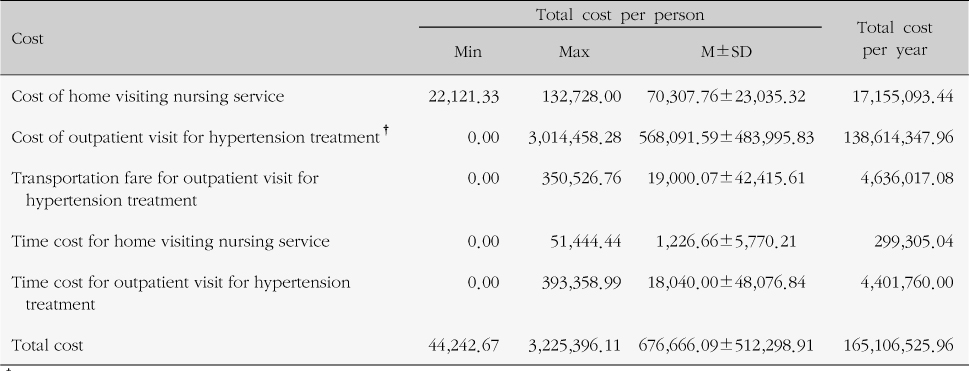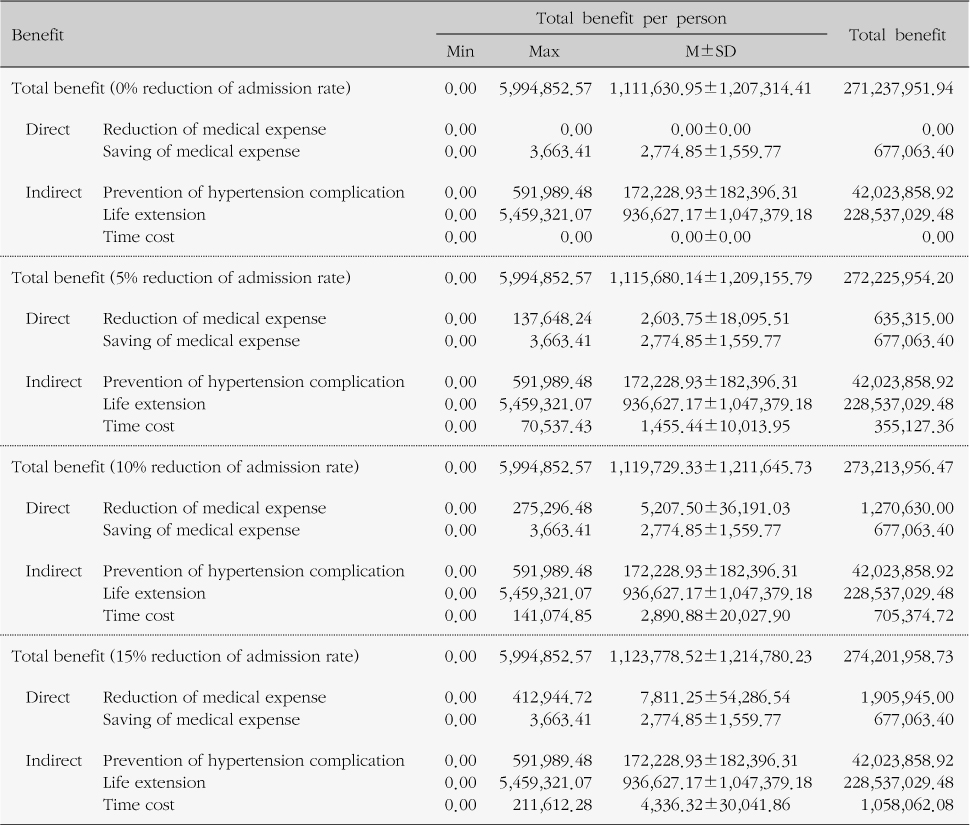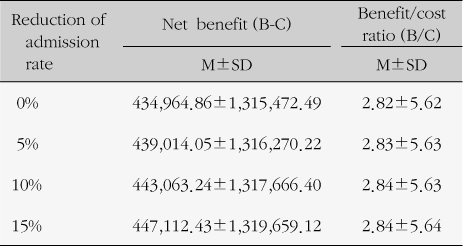Articles
- Page Path
- HOME > J Korean Acad Community Health Nurs > Volume 22(4); 2011 > Article
-
Original Article
- Cost-benefit Analysis of Home Visiting Care for Vulnerable Populations with Hypertension
- Young Ko, In Sook Lee
-
Journal of Korean Academy of Community Health Nursing 2014;22(4):438-450.
DOI: https://doi.org/10.12799/jkachn.2011.22.4.438
Published online: April 4, 2014
1Full-time Lecturer, College of Nursing, Eulji University, Korea.
2Professor, College of Nursing, Seoul National University, Korea.
• Received: September 24, 2011 • Revised: December 15, 2011 • Accepted: December 15, 2011
© 2011 Korean Academy of Community Health Nursing
This is an Open Access article distributed under the terms of the Creative Commons Attribution Non-Commercial License (http://creativecommons.org/licenses/by-nc/3.0/) which permits unrestricted non-commercial use, distribution, and reproduction in any medium, provided the original work is properly cited.
- 885 Views
- 5 Download
- 10 Crossref
Abstract
-
Purpose
- This study was to investigate the effect of home visiting care service and to evaluate the effect from the cost-benefit perspective.
-
Methods
- Target participants were enrolled in 2007~2008 for home visiting care and provided with a home visiting nursing service for more than 18 months in J Ward of S City. Of 391 participants, 244 who satisfied the inclusion criteria were used in the final analysis. Cost-benefit analysis was done using the net benefit and benefit/cost ratio.
-
Results
- After providing the home care nursing service, the blood pressure control rate increased from 50.8% to 75.4%. Of the subjects, 39.8% maintained their blood pressure level within the target range. As a whole, the net benefit of home visiting care per person ranged from 434,964.86 to 447,112.43 won and the benefit/cost ratio ranged from 2.82 to 2.84.
-
Conclusion
- Home visiting care for vulnerable populations with hypertension was effective in both maintaining blood pressure and reducing blood pressure to the target range. Therefore these results are especially useful for establishing the value of home visiting services for policy makers as well as for prioritizing vulnerable populations.
-
This article is revision of the first author's doctoral thesis from Seoul National University.
NOTES
- 1. Ahn YO, Kim DH, Bae JM, Lee MS, Shin MH, Lee SI. A study on effective implementation of health examination. Seoul: National Health Insurance Corporation; 1995.
- 2. Alcocer L, Cueto L. Review: Hypertension, a health economics perspective. Ther Adv Cardiovasc Dis. 2008;2:147–155. doi: 10.1177/1753944708090572ArticlePubMedPDF
- 3. Bae SI, Kim JS, Park IS. The cost-benefit analysis for high blood pressure in health examination. Korean J Health Econ Policy. 2005;11:39–61.
- 4. Bae S, Kim J, Min K, Kwon S, Han D. Patient compliance and associated factors in the community-based hypertension control program. Korean J Prev Med. 1999;32:215–227.
- 5. Cantor JC, Morisky DE, Green LW, Levine DM, Salkever DS. Cost-effectiveness of educational interventions to improve patient outcomes in blood pressure control. Prev Med. 1985;14:782–800. doi: 10.1016/0091-7435(85)90071-4ArticlePubMed
- 6. Collins R, Peto R, MacMahon S, Hebert P, Fiebach NH, Eberlein KA, et al. Blood pressure, stroke, and coronary heart disease. part 2, short-term reductions in blood pressure: overview of randomised drug trials in their epidemiological context. Lancet. 1990;335:827–838. doi: 10.1016/0140-6736(90)90944-ZPubMed
- 7. Earp JA, Ory MG, Strogatz DS. The effects of family involvement and practitioner home visits on the control of hypertension. Am J Public Health. 1982;72:1146–1154. ArticlePubMedPMC
- 8. Grover SA, Coupal L, Kaouache M, Lowensteyn I. Preventing cardiovascular disease among canadians: What are the potential benefits of treating hypertension or dyslipidemia? Can J Cardiol. 2007;23:467–473. doi: 10.1016/S0828-282X(07)70786-9ArticlePubMedPMC
- 9. Jung YH, Ko SJ. Estimating socioeconomic costs of five major disease. Public Finance Rev. 2004;18:77–104.
- 10. Kang YS, Lee SJ, Yang BM, Hur J. Cost-benefit analysis of nursing intervention program for the aged. J Korea Gerontol Soc. 1988;8:120–144.
- 11. Kaplan GA, Keil JE. Socioeconomic factors and cardiovascular disease: A review of the literature. Circulation. 1993;88:1973–1998. ArticlePubMed
- 12. Kim JH, Lee HY, Jung HJ. 2007 National health insurance statistical yearbook. Seoul: Health Insurance Review & Assessment Service, National Health Insurance Corporation; 2008.
- 13. Ko IS, Kim GS, Lim MH, Lee KJ, Lee TW, Park HS, et al. Effects of health education on the knowledge and self-care of hypertension for visiting nursing clients. J Korean Acad Public Health Nurs. 2007;21:134–145.
- 14. Korea Center for Disease Control and Prevention. 2007 National health statistics: the first year (2007) of the 4th the national health and nutrition examination survey 2008;12;Retrieved October 5, 2009. from http://knhanes.cdc.go.kr
- 15. Lee JY, Kim HL, Kim YH. Difference of self-care behavior implementation in clients with hypertension by visiting nursing service. Chungnam J Nurs Acad. 2006;9:53–62.
- 16. Lee TW, Ko IS. Cost-benefit analysis on community health practitioner. J Korean Acad Nurs. 2002;32:435–446. ArticlePDF
- 17. Liljas B. How to calculate indirect costs in economic evaluations. Pharmacoeconomics. 1998;13(1 Pt 1):1–7. ArticlePubMed
- 18. Management Center For Health Promotion. Estimation of optimal workload for the visiting nurse of customizing health care through the job analysis. Seoul: Ajou University, Management Center For Health Promotion; 2009-a. 03.
- 19. Management Center For Health Promotion. 2007 Customized home visiting care project yearbook. Seoul: Management Center For Health Promotion, Ministry of Health, Welfare and Family Affairs; 2009-b. 12.
- 20. Ministry of Health and Welfare. Result report of customized home visiting care project in 2007. Seoul: Ministry of Health and Welfare; 2007. 11.
- 21. Ministry of Labor. Survey report on wage structure. Seoul: Ministry of Labor; 2008. 05.
- 22. Ministry of Public Administration and Security. Civil service pay. guidance 2008;06;Retrieved December 15, 2009. from www.mopas.go.kr
- 23. Park JG, Choi MJ. Automobile insurance. Incheon: SunHak Press; 2004.
- 24. Park KO. Nurse! Why do they leave small and medium hospitals? Korean Nurses Association Policy Forum, Seoul, Korea 2008;11;Retrieved November 20, 2009. from http://www.khna.or.kr/resource/frame_data.php
- 25. Shin HS, Lee TJ, Yang BM. The economic analysis on visiting nurse program. J Ins Health Environ Sci. 1993;3:9–17.
- 26. Statistics Korea. Economic activity participation rate and consumer price index 2009;Retrieved October 24, 2009. from http://www.kostat.go.kr/
- 27. The Korean Society of Hypertension. 2004 Korean hypertension treatment guidelines. Seoul: Committee on Guidelines of Hypertension Treatment, The Korean Society of Hypertension; 2004. 12.
- 28. World Health Organization. The world health report 2002-reducing risks, promoting healthy life. Geneva: World Health Organization; 2002. 10.
- 29. Yang BM, Kim JH, Lee SY. The economic analysis of industrial health promotion program: A cost-benefit analysis of preventing occupational disease program in Korea. Seoul: Ministry of Labor; 1992.
- 30. Yonsei University Health Promotion Project Support Group. Cost-effectiveness analysis of national prevention programs for cardiovascular disease. Seoul: Management Center for Health Promotion, The Korea Institute for Health and Social Affairs; 2007.
Figure & Data
References
Citations
Citations to this article as recorded by 

- A Study on Outcomes of the Utilization of Visiting Nursing Service at the Integrated Visiting Nursing Center in Bucheon-si
Hyun-Kyung Park, Ae Jung Yoo, Ju Young Yoon, Jae Woo Choi
Research in Community and Public Health Nursing.2023; 34: 127. CrossRef - Types of Perception of Home Visiting Oral Health Care Services for Korean Older Persons: A Q Methodology Study
Sue-Hyang Lee, Soo-Myoung Bae, Bo-Mi Shin, Sun-Jung Shin
International Journal of Environmental Research and Public Health.2020; 18(1): 214. CrossRef - Nursing Students' Practice Experience on Community Visiting Nursing
Jae-Hyun Ha, Jeong-Hee Park
Journal of Korean Academy of Community Health Nursing.2020; 31(1): 43. CrossRef - Cost-Benefit Analysis of Occupational Therapy in Center for Dementia Based on Public Data
Seung-Hyun Cho, Kyung-Yoon Kam, Sung-Yoon Bae, Nam-Hoon Cho, Hye-Won Oh, Young-Ae Yang
Journal of Korean Society of Occupational Therapy.2018; 26(2): 99. CrossRef - Comparison of Working Conditions among Non-regular Visiting Nurses in Public Health Centers based on Their Employment Types
Hee Girl Kim, Ryoun-Sook Lee, Soong-Nang Jang, Kwang Byung Kim, Young Ran Chin
Journal of Korean Academy of Community Health Nursing.2018; 29(3): 267. CrossRef - The Study for Improvement of Frailty and Depression in the Health Vulnerable Elderly of Home Visiting Health Care Service
Youngji Kim, Song-Nang Jang
Journal of the Korean Geriatrics Society.2016; 20(2): 85. CrossRef - The Cost-Benefit Analysis of the NutriPlus Program in Daejeon Dong-gu Health Center
Hyun Ju Kim, Sung Han Kim
The Korean Journal of Food And Nutrition.2015; 28(4): 717. CrossRef - Estimating need for Home Visiting Nurse from Public Health Centers
Hyun-Ji Bae, Jinhyun Kim
Perspectives in Nursing Science.2015; 12(1): 23. CrossRef - Development of the evaluation tool for the food safety and nutrition management education projects targeting the middle class elderly: Application of the balanced score card and the structure-process-outcome concept
Hyeja Chang, Hyoi Yoo, Harim Chung, Hyesang Lee, Minjune Lee, Kyungeun Lee, Changhee Yoo, Junghwa Choi, Nayoung Lee, Tongkyung Kwak
Journal of Nutrition and Health.2015; 48(6): 542. CrossRef - Effectiveness of Telemedicine: Videoconferencing for Low-Income Elderly with Hypertension
Hanna Choi, Jeongeun Kim
Telemedicine and e-Health.2014; 20(12): 1156. CrossRef

 KACHN
KACHN





 PubReader
PubReader Cite
Cite


